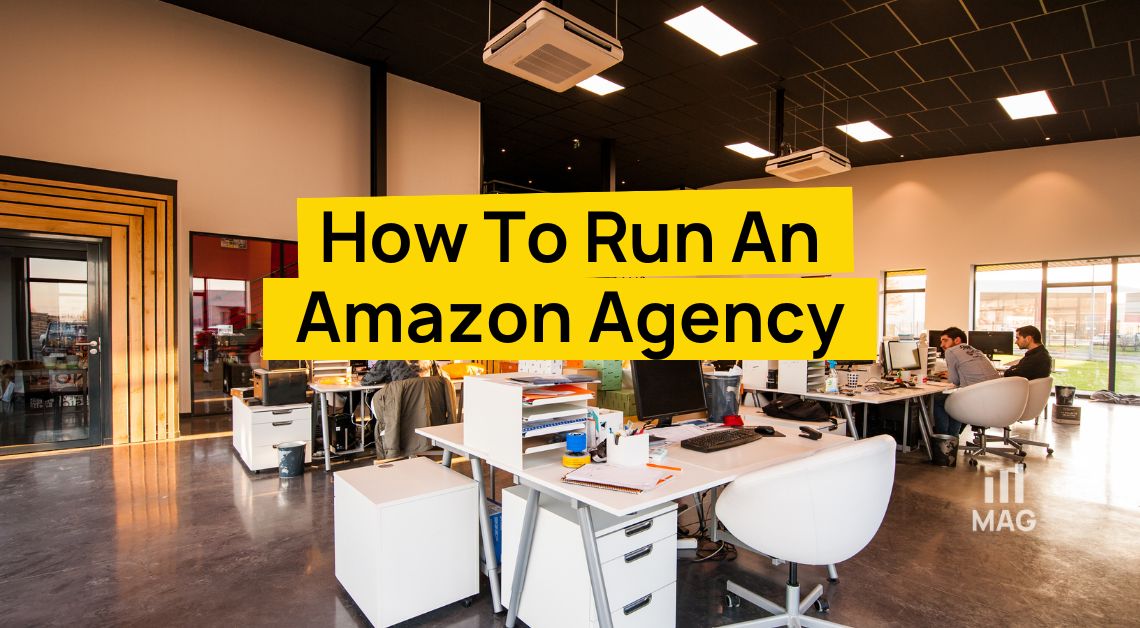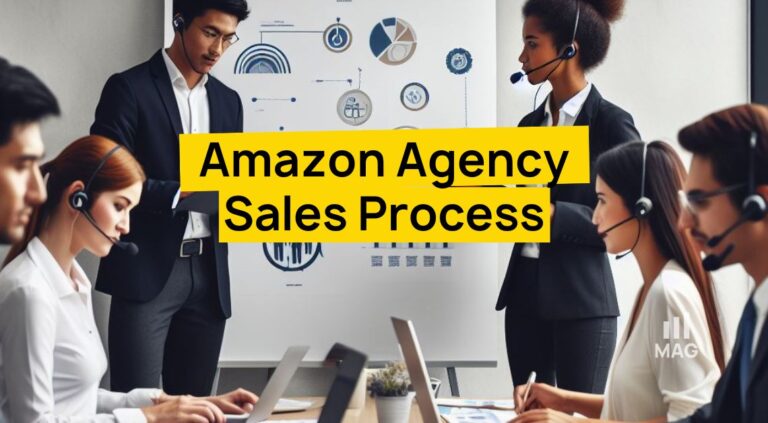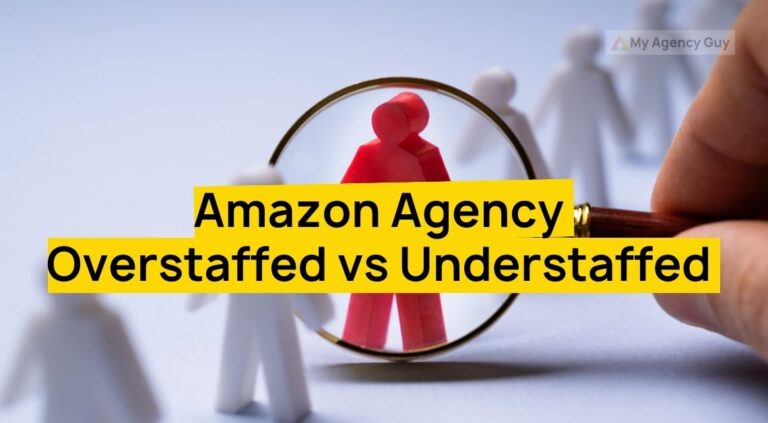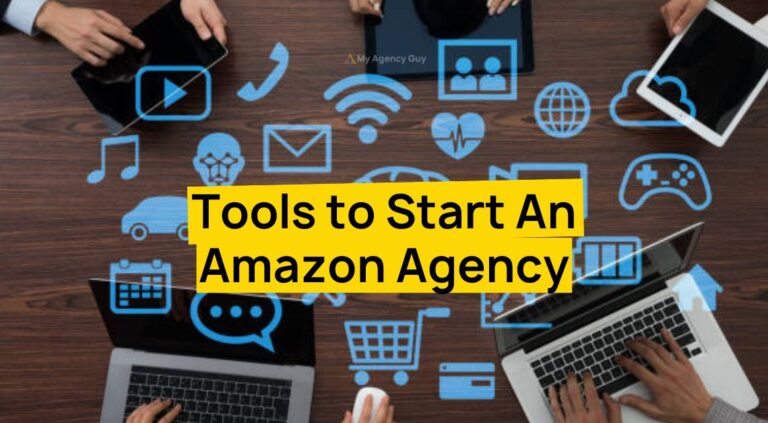A Definitive Guide On How To Run An Amazon Agency
Understanding how to run an Amazon agency is akin to mastering the intricate art of navigating a bustling marketplace. It’s about strategically blending expertise, operational finesse, and client-centric approaches to drive success in the dynamic realm of e-commerce.
Intrigued by the prospect of scaling a profitable Amazon agency? Dive deeper into this guide as we unravel the intricate web of strategies and insights, each page offering a roadmap to amplify your agency’s profitability.
Before we dive into the details, here are some videos you can watch on how to run an Amazon Agency:
Playlist
How to Run An Amazon Agency: Client Acquisition
Acquiring clients for an Amazon agency involves various strategies and tactics. Here are some key approaches to consider:
- Networking and Referrals: Build relationships with industry professionals, attend e-commerce conferences, and join relevant online communities to connect with potential clients. Encourage satisfied clients to refer your agency to others.
- Online Presence and Content Marketing: Establish a strong online presence through a professional website, social media channels, and a blog. Create valuable content that showcases your expertise in Amazon selling and attracts potential clients.
- Targeted Advertising: Utilize targeted advertising campaigns on platforms like Google Ads, Facebook Ads, and LinkedIn Ads to reach potential clients who are actively searching for Amazon agency services.
- Case Studies and Testimonials: Highlight successful client case studies and testimonials on your website and marketing materials. Demonstrating your agency’s track record and positive results can help attract new clients.
- Partnerships and Collaborations: Collaborate with complementary service providers, such as web developers, graphic designers, or marketing agencies, to offer bundled services or cross-promote each other’s services.
- Email Marketing: Build an email list of potential clients and regularly send out informative newsletters, industry updates, success stories, and promotional offers to nurture leads and stay top-of-mind.
- Cold Outreach: Identify potential clients through market research and reach out to them directly via email or LinkedIn. Personalize your approach and highlight how your agency can address their specific pain points.
- Industry Events and Webinars: Host or participate in industry events, webinars, or workshops to showcase your expertise and establish your agency as a thought leader in the Amazon selling space.
- Optimized Website and SEO: Ensure your agency’s website is optimized for search engines so that potential clients can find you when searching for Amazon agency services. Use relevant keywords, create informative content, and optimize your website’s structure.
- Participate in Amazon Seller Communities: Engage with Amazon seller communities, forums, and online groups to establish your agency’s presence, provide valuable advice, and connect with potential clients.
Identify Target Market
When it comes to identifying your target market for Amazon agency client acquisition, there are several key factors to consider. Here are three relevant topics to help you in this process:
- Product Category Analysis: Analyzing different product categories can help you identify which industries or niches align best with your agency’s expertise and services. Consider the level of competition, market size, and growth potential within each category. By focusing on specific product categories where you have a competitive advantage, you can effectively position your agency and tailor your marketing efforts to attract clients in those areas.
- Seller Profile Evaluation: Understanding the characteristics and needs of your ideal clients is crucial. Evaluate the types of sellers or businesses that benefit most from your agency’s services. Consider factors such as their size (e.g., small businesses, mid-sized brands, enterprise-level sellers), their level of experience with Amazon, their target market or customer base, and their specific pain points or challenges. This evaluation will help you create targeted marketing messages and strategies that resonate with your target clients.
- Data-driven Research: Utilize data-driven research tools and resources to gain insights into your target market. Amazon provides various tools like Brand Analytics, which can offer valuable demographic information about your potential customers. Analyze customer demographics, including age, household income, education, gender, and marital status, to gain a better understanding of who your target audience is and how to effectively connect with them. Additionally, leverage market research tools and competitor analysis to identify gaps and opportunities within your target market.
By combining these approaches, you can narrow down your target market for Amazon agency client acquisition. This will enable you to develop targeted marketing strategies, tailor your services to meet their needs, and effectively connect with potential clients who are most likely to benefit from your expertise.
Build Trust and Demonstrate Expertise
Building trust and demonstrating expertise are crucial elements in Amazon agency client acquisition. Here are three relevant topics to consider:
- Case Studies and Success Stories: Sharing case studies and success stories of previous clients can be a powerful way to build trust and demonstrate your agency’s expertise. Highlight specific challenges your clients faced and how your agency helped them overcome those challenges and achieve success on Amazon. Include measurable results and testimonials to showcase the tangible impact of your services. This social proof can instill confidence in potential clients and show them that your agency has a track record of delivering results.
- Testimonials and Reviews: Encourage satisfied clients to provide testimonials and reviews about their experience working with your agency. These testimonials can be showcased on your website, social media platforms, and other marketing materials. Positive reviews and testimonials from real clients serve as powerful endorsements and help to build trust with potential clients. Consider also leveraging third-party review platforms like Trustpilot or Google Reviews to further enhance your agency’s credibility.
- Thought Leadership and Education: Establishing your agency as a thought leader in the Amazon space can significantly contribute to building trust and demonstrating expertise. Create valuable content such as blog posts, videos, webinars, or podcasts that provide insights, tips, and strategies related to selling on Amazon. Share this content on your agency’s website, social media channels, and through industry publications. By offering valuable education and thought leadership, you position your agency as a knowledgeable resource and expert in the field.
By leveraging case studies, testimonials, and thought leadership content, you can build trust and demonstrate your agency’s expertise in the Amazon marketplace. These efforts will help differentiate your agency from competitors and attract potential clients who are looking for a trusted and knowledgeable partner to help them succeed on Amazon.
How to Run An Amazon Agency: Account Management
Running an Amazon agency involves effective account management to ensure the success and satisfaction of your clients. Here are three key aspects to consider when it comes to account management for your Amazon agency:
- Regular Communication and Updates: Maintain open lines of communication with your clients on a regular basis. Schedule regular check-ins to discuss performance, strategies, and any updates or changes in the Amazon ecosystem. Provide detailed reports and insights regarding key metrics such as sales, advertising performance, and inventory management. Proactively address any concerns or issues raised by clients and keep them informed about the progress of their Amazon accounts.
- Optimization and Performance Analysis: Continuously monitor and optimize your clients’ Amazon accounts to maximize performance and drive results. Conduct regular audits to ensure that product listings are optimized with relevant keywords, compelling product descriptions, and high-quality images. Monitor advertising campaigns to optimize bid strategies, keyword targeting, and ad placements. Analyze data and metrics to identify areas of improvement and implement strategies to enhance sales and profitability.
- Stay Updated with Amazon Policies and Best Practices: Amazon’s policies and best practices are constantly evolving. It’s crucial to stay updated with any changes and ensure that your clients’ accounts are compliant. Follow Amazon’s guidelines for product listing optimization, advertising policies, inventory management, and customer service. Stay informed about industry trends, new features, and tools on the Amazon platform to leverage them for the benefit of your clients.
Additionally, consider offering value-added services such as Amazon Sponsored Products or Brand Registry enrollment, A+ content creation, or Amazon Storefront set up to further enhance your clients’ Amazon presence and drive sales.
By prioritizing regular communication, optimization, and staying updated with Amazon policies, you can effectively manage your clients’ Amazon accounts and help them achieve their business goals. This proactive approach to account management will not only build trust and satisfaction with your clients but also contribute to the long-term success of your Amazon agency.
Client relationship management (CRM)
When choosing a CRM system for your clients as an Amazon agency, you need to consider the following factors:
- Features: What features are important to your clients? Do they need a CRM system with lead management, contact management, opportunity tracking, task management, and reporting features?
- Ease of use: The CRM system should be easy to use for both you and your clients. It should have a user-friendly interface and be easy to navigate.
- Integrations: Does the CRM system integrate with other tools and platforms that your clients use, such as Amazon Seller Central and Amazon Advertising?
- Pricing: CRM systems can range in price from free to hundreds of dollars per month. Choose a CRM system that fits your clients’ budget.
Here are some of the top CRM systems for Amazon agencies:
- Salesforce: Salesforce is a popular CRM system that offers a wide range of features, including lead management, contact management, opportunity tracking, task management, and reporting. Salesforce also integrates with a number of other tools and platforms, such as Amazon Seller Central and Amazon Advertising.
- HubSpot: HubSpot is a CRM system that is designed for small businesses. It offers a free version with basic features, as well as paid versions with more advanced features. HubSpot also integrates with a number of other tools and platforms, such as Amazon Seller Central and Amazon Advertising.
- Zoho CRM: Zoho CRM is a CRM system that is known for its affordability and ease of use. It offers a free version with basic features, as well as paid versions with more advanced features. Zoho CRM also integrates with a number of other tools and platforms, such as Amazon Seller Central and Amazon Advertising.
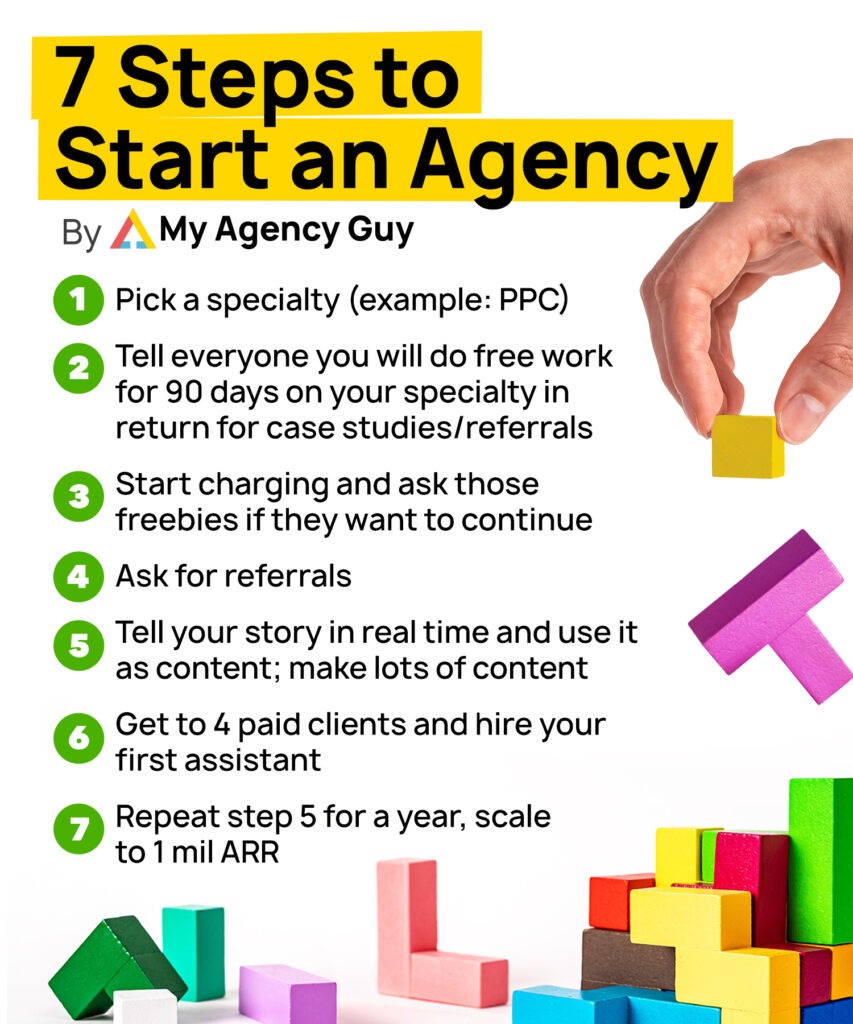
How to Run An Amazon Agency: Marketing
Marketing is an essential part of running any business, including an Amazon agency. By marketing your agency effectively, you can attract new clients and grow your business.
Here are some tips on how to market your Amazon agency:
- Create a strong brand identity: Your brand identity is what will set your agency apart from the competition. Make sure that your brand is consistent across all of your marketing materials, from your website to your social media pages.
- Develop a marketing strategy: Your marketing strategy should outline your goals, target audience, and the channels you will use to reach them.
- Create high-quality content: One of the best ways to market your agency is to create high-quality content that is relevant to your target audience. This could include blog posts, articles, infographics, and videos.
- Use social media: Social media is a great way to connect with potential clients and promote your agency’s content. Make sure to be active on the social media platforms that your target audience uses.
- Run paid advertising campaigns: Paid advertising campaigns can be a great way to reach a larger audience and generate leads. However, it is important to create targeted campaigns and to track your results so that you can see what is working and what is not.
Implement Marketing Strategies
- Offer a free consultation: This is a great way to attract new clients and to learn more about their needs.
- Create case studies: Case studies are a great way to showcase your agency’s expertise and to demonstrate the results that you have achieved for your clients.
- Run webinars and workshops: This is a great way to share your knowledge with potential clients and establish yourself as an expert in the Amazon industry.
- Attend industry events: This is a great way to network with potential clients and to learn about the latest trends in the Amazon industry.
- Partner with other businesses: Partnering with other businesses can help you to reach a larger audience and to offer your clients a wider range of services.
How to Run An Amazon Agency: Finance
The financial aspects of running an Amazon agency are essential to its success. By properly managing your finances, you can ensure that your agency is profitable and sustainable in the long term.
What Are The Things I Need To Consider About The Finance Matters Of Running An Amazon Agency?
When it comes to the financial aspects of running an Amazon agency, there are several important considerations to keep in mind:
- Initial Investment: Starting an Amazon agency requires an initial investment for setting up your business, including office space, equipment, software, and hiring employees.
- Operating Costs: You need to budget for ongoing expenses such as employee salaries, software subscriptions, advertising costs, inventory, shipping fees, and other overhead expenses.
- Revenue Streams: As an Amazon agency, your main revenue streams will come from client fees or commissions for managing their Amazon accounts. It’s important to have a clear understanding of how you will structure your pricing and fees to ensure profitability.
- Cash Flow Management: Managing cash flow is crucial for any business. You need to carefully track incoming revenue, outgoing expenses, and ensure you have enough working capital to cover any unexpected costs or fluctuations in client payments.
- Profit Margins: Understanding your profit margins is essential for long-term sustainability. It’s important to analyze your costs and pricing structure to ensure you are generating enough profit to cover your expenses and achieve your financial goals.
- ROI Analysis: Regularly analyzing the return on investment (ROI) for your marketing campaigns and client accounts is crucial. This will help you identify areas of improvement, optimize your strategies, and ensure you are delivering value to your clients.
- Financial Reporting: Maintaining accurate and up-to-date financial records is important for monitoring the financial health of your agency. This includes tracking revenue, expenses, profit and loss statements, and balance sheets.
- Tax Obligations: As a business owner, you need to be aware of your tax obligations and ensure compliance with local tax laws. It’s recommended to work with a qualified accountant or tax professional to ensure you meet all your tax requirements.
Remember, financial management is a critical aspect of running any business, and it’s essential to regularly review and adjust your financial strategies to ensure the success and growth of your Amazon agency.
Some Tips On Managing Your Amazon Agency’s Finances
- Set pricing: When setting your prices, you need to consider a number of factors, such as the cost of providing your services, the value you provide to your clients, and the prices of your competitors. You also need to make sure that your prices are profitable.
- Track your expenses: It is important to track all of your expenses, such as salaries, rent, marketing costs, and software subscriptions. This will help you to identify areas where you can cut costs or increase your revenue.
- Calculate your profit: Once you have tracked your income and expenses, you can calculate your profit. This will help you to understand how profitable your agency is and to make necessary adjustments to your pricing or expenses.
- Manage your cash flow: Cash flow is the movement of money into and out of your business. It is important to manage your cash flow carefully to ensure that you have enough money to cover your expenses and invest in your business.
- Pay your taxes on time: It is important to pay your taxes on time to avoid penalties and interest charges. You should consult with a tax professional to get advice on how to structure your business and comply with all applicable tax laws.
- Invest in the right technology: The right technology can help you to automate tasks, improve efficiency, and better serve your clients. However, it is important to invest in the right technology for your needs and to budget accordingly.
- Hire the right team: Hiring the right team is essential for running a successful Amazon agency. When hiring staff, look for people who are experienced, qualified, and passionate about Amazon.
- Get professional help: If you are not comfortable managing your own finances, you can hire a professional accountant or financial advisor to help you.
- By following these tips, you can manage the finances of your Amazon agency effectively and ensure that your business is profitable and sustainable.
- Create a budget: A budget will help you to track your income and expenses and to make sure that you are staying on track financially.
- Set financial goals: What do you want to achieve with your Amazon agency? Do you want to grow your business, increase your profits, or achieve a certain level of profitability? Once you know what you want to achieve, you can set financial goals to help you get there.
- Review your finances regularly: It is important to review your finances regularly to identify any areas where you can improve. This could include reducing expenses, increasing revenue, or adjusting your pricing.
How to Run An Amazon Agency: Human Resources
Running an Amazon agency requires effective management of human resources to ensure the success of your business. Here are some key considerations for managing human resources in an Amazon agency:
- Recruitment and Hiring: Develop a clear understanding of the roles and responsibilities needed in your agency. Create job descriptions and qualifications that align with the specific needs of your agency. When hiring, focus on competency and skills relevant to the job, as Amazon prioritizes competency-based hiring.
- Training and Development: Provide comprehensive training to new employees to ensure they understand your agency’s processes, tools, and strategies. Invest in continuous learning and development programs to keep your team updated with the latest trends and best practices in Amazon selling.
- Performance Management: Implement a performance management system to set clear expectations, provide regular feedback, and conduct performance evaluations. Set goals and targets for your team members, and recognize and reward their achievements.
- Communication and Collaboration: Foster open and transparent communication within your agency. Encourage collaboration and teamwork to maximize productivity and efficiency. Leverage tools and platforms for effective communication, such as project management software or team messaging apps.
- Employee Engagement and Retention: Create a positive work environment that promotes employee engagement and satisfaction. Offer competitive compensation packages, provide opportunities for growth and advancement, and recognize and reward outstanding performance to enhance employee retention.
- Conflict Resolution: Develop effective conflict resolution mechanisms to address any issues or disputes that may arise among team members. Encourage open dialogue and provide mediation or coaching if needed to resolve conflicts in a constructive manner.
- Compliance and Legal Considerations: Ensure compliance with labor laws and regulations relevant to your jurisdiction. Stay updated on employment laws, including those related to wages, working hours, and benefits, to avoid any legal issues.
- Employee Well-being: Prioritize the well-being of your employees by promoting work-life balance, providing a safe and healthy work environment, and offering employee benefits such as health insurance or wellness programs.
Remember, effective human resource management is crucial for building a talented and motivated team that can drive the success of your Amazon agency. Regularly assess and adapt your HR strategies to meet the evolving needs of your business and employees.
Additional Tips For Managing The HR Aspects Of Running An Amazon Agency
- Develop a company culture: Your company culture is what sets your agency apart from other agencies. It is important to develop a company culture that is positive, supportive, and productive.
- Create an employee handbook: An employee handbook is a document that outlines your company’s policies and procedures. It is an important resource for your employees and it can help to resolve disputes.
- Offer competitive salaries and benefits: It is important to offer your employees competitive salaries and benefits. This will help you to attract and retain top talent.
- Provide training and development opportunities: It is important to provide your employees with training and development opportunities. This will help them to stay up-to-date on the latest trends and technologies, and it will also help them to grow and develop in their careers.
- Recognize and reward your employees: It is important to recognize and reward your employees for their hard work and accomplishments. This will help to keep them motivated and engaged in their work.
Here are some related videos to watch:
Playlist
How to Run An Amazon Agency: Technology
Running an Amazon agency efficiently and effectively requires leveraging technology to streamline processes, optimize performance, and drive growth. Here are some key aspects to consider when it comes to technology in running an Amazon agency:
- Amazon Seller Central: Familiarize yourself with the features and functionalities of Amazon Seller Central, the platform where you will manage your clients’ Amazon accounts. Learn how to navigate the dashboard, analyze data, and utilize tools to optimize listings, manage inventory, and monitor performance.
- Listing Optimization Tools: Utilize listing optimization tools to enhance product listings, improve keyword rankings, and increase visibility on Amazon. These tools can help with keyword research, competitor analysis, and provide recommendations to optimize titles, bullet points, descriptions, and backend keywords.
- Inventory Management Software: Implement inventory management software to efficiently track and manage your clients’ inventory levels. This helps prevent stockouts, minimize storage fees, and ensure timely replenishment to meet customer demand.
- Advertising and Marketing Tools: Utilize advertising and marketing tools to drive traffic and sales for your clients’ Amazon listings. Tools like Amazon Advertising, sponsored ads, and display ads can help increase product visibility and reach potential customers.
- Data Analytics and Reporting: Leverage data analytics tools to gain insights into your clients’ Amazon performance. Analyze key metrics such as sales, conversion rates, click-through rates, and customer reviews to identify trends, opportunities, and areas for improvement.
- Repricing Software: Consider using repricing software to automatically adjust product prices based on market conditions, competitor prices, and predefined pricing strategies. This can help maximize sales and stay competitive in the Amazon marketplace.
- Order and Shipping Management: Implement order and shipping management tools to streamline the fulfillment process, track shipments, and provide accurate delivery information to customers. This helps ensure a smooth customer experience and reduces fulfillment errors.
- Customer Feedback and Review Management: Utilize tools to monitor and manage customer feedback and reviews. This includes automating feedback requests, tracking review ratings, and addressing customer concerns promptly to maintain a positive brand reputation.
- CRM and Customer Support: Implement a customer relationship management (CRM) system to manage client relationships, track communication history, and provide efficient customer support. This helps maintain strong client relationships and ensures effective communication.
- Project Management and Collaboration Tools: Utilize project management and collaboration tools to streamline workflows, assign tasks, and facilitate communication within your team. Tools like Asana, Trello, or Slack can help improve productivity and ensure smooth operations.
Read this LinkedIn post from My Amazon Guy’s VP of Finance, Dustin Fenton, where he talked about the productive results that our company gained after switching to Invoice Ninja.
Utilize AI Tools
AI tools can play a significant role in helping your Amazon agency streamline processes, optimize performance, and drive growth.There’s a growing number of AI Tools available to Amazon enthusiasts, such as My Amazon Guy’s MAGai.
MAGai is an advanced AI assistant designed to assist Amazon sellers and agencies with various aspects of their business. Here are a few ways MAGai can benefit your Amazon agency:
- Streamlined Processes: MAGai can help automate repetitive tasks and streamline your agency’s processes. This can save you time and increase efficiency, allowing your team to focus on more important aspects of your business.
- Data Analysis: MAGai can assist in analyzing data related to your Amazon business. It can help you uncover trends, identify opportunities for growth, and make data-driven decisions to optimize your listings, advertising campaigns, and inventory management.
- Keyword Research: MAGai can help you identify relevant keywords for your product listings. By analyzing search volume and competition, it can provide valuable insights to improve your product visibility and increase organic traffic to your listings.
- Listing Optimization: MAGai can provide recommendations on how to optimize your product listings to improve their visibility and conversion rates. It can analyze various factors such as title, bullet points, product descriptions, and images to help you create compelling listings that resonate with your target audience.
- Advertising Strategies: MAGai can assist in developing effective advertising strategies for your Amazon campaigns. It can help you identify the most relevant keywords, optimize your ad spend, and track performance metrics to maximize your return on investment.
- Competitive Analysis: MAGai can help you monitor and analyze your competitors’ performance on Amazon. It can provide insights into their pricing strategies, product assortment, and customer reviews, enabling you to stay competitive in the marketplace.
By leveraging technology effectively, you can optimize operations, enhance client performance, and drive growth for your Amazon agency. Stay up to date with the latest tools and technologies, and continuously evaluate and adapt your tech stack to meet the evolving needs of your agency and clients.
How to Run An Amazon Agency: Process Improvement
Process improvement is the ongoing process of identifying and eliminating inefficiencies in your business processes. This can lead to significant savings in time and money, as well as improved customer service and quality.
How To Improve Processes In Your Amazon Agency:
- Identify your processes: The first step is to identify all of the processes in your business. This includes both the processes that you use to manage your clients’ accounts and the processes that you use to run your own business.
- Map out your processes: Once you have identified your processes, map them out. This will help you to visualize your processes and identify areas where there may be inefficiencies.
- Identify areas for improvement: Once you have mapped out your processes, identify areas where there may be inefficiencies. This could include areas where there is duplication of effort, where steps could be eliminated, or where technology could be used to automate tasks.
- Implement improvements: Once you have identified areas for improvement, implement those improvements. This may involve changing your procedures, investing in new technology, or training your staff on new ways of working.
- Monitor your results: Once you have implemented improvements, monitor your results to see if they are effective. If they are not, make further adjustments.
Here are some additional tips for improving processes in your Amazon agency:
- Get feedback from your team: Your team members are the ones who are using your processes on a daily basis, so they are the best people to identify areas for improvement. Ask your team members for feedback on your processes and listen to their suggestions.
- Use data to drive your decisions: Don’t rely on gut instinct when making decisions about process improvement. Use data to identify areas where your processes are falling short. For example, you could use data to track how long it takes to complete certain tasks or to identify areas where there are a high number of errors.
- Don’t be afraid to experiment: The best way to find the most efficient way to do something is to experiment. Try different things and see what works best. Don’t be afraid to make mistakes, and be willing to change your approach if something isn’t working.
- Use templates: Templates can help you to save time and ensure consistency in your work. For example, you could use templates for product descriptions, customer emails, and advertising campaigns.
- Automate tasks: There are a number of tasks that you can automate using software. For example, you could automate the process of sending customer emails, creating product listings, or managing your advertising campaigns.
- Delegate tasks: Don’t try to do everything yourself. Delegate tasks to your team members so that you can focus on the most important things.
- Set deadlines: Setting deadlines will help you to stay on track and avoid procrastination.
How to Run An Amazon Agency: Growth Strategy
Running a successful Amazon agency requires a well-defined growth strategy. Here are some key elements to consider when developing a growth strategy for your Amazon agency:
- Expand Service Offerings: Evaluate your agency’s current service offerings and consider expanding into new areas. This could include offering additional services such as product photography, video production, brand consulting, or international expansion. By diversifying your services, you can attract a wider range of clients and increase revenue streams.
- Target Niche Markets: Identify and target specific niche markets where you can provide specialized expertise. This allows you to differentiate your agency from competitors and position yourself as an industry expert. By focusing on niche markets, you can better understand your target audience’s needs and tailor your services to meet their specific requirements.
- Client Referrals: Leverage your existing client base to generate referrals. Satisfied clients can be a powerful source of new business. Implement a referral program that incentivizes your clients to refer other sellers or businesses to your agency. This can include offering discounts, bonuses, or other incentives for successful referrals.
- Strategic Partnerships: Form strategic partnerships with complementary service providers, such as graphic designers, copywriters, or PPC experts. By collaborating with other professionals in the industry, you can offer comprehensive solutions to your clients and tap into their networks to generate new leads.
- Thought Leadership: Establish your agency as a thought leader in the Amazon industry. Publish informative and valuable content through blog posts, whitepapers, webinars, or videos. This helps build credibility, attract potential clients, and position your agency as a go-to resource for Amazon-related insights and strategies.
- Attend Industry Events: Participate in industry events, conferences, and trade shows. These events provide opportunities to network with potential clients, showcase your agency’s expertise, and stay up-to-date with the latest trends and developments in the Amazon ecosystem.
- Continuous Learning and Adaptation: Stay proactive and continuously adapt your strategies based on changes in the Amazon marketplace. Stay updated with Amazon’s policies, algorithm updates, and industry trends. This allows you to provide the most effective strategies and solutions to your clients, ensuring their success and driving growth for your agency.
Remember, developing a growth strategy requires a thorough understanding of your agency’s strengths, target market, and the Amazon ecosystem. By implementing a well-planned growth strategy, you can position your agency for long-term success and expansion.
Target New Markets
There are a few key indicators that it may be time to target a new market as an Amazon agency:
- Your existing market is saturated: If you are finding it difficult to attract new clients or to grow your market share in your existing market, it may be time to look for new markets to target.
- You have the expertise and resources to serve a new market: If you have the expertise and resources to serve a new market, then it is definitely worth considering.
- There is a demand for your services in a new market: If there is a demand for your services in a new market, then it is a good opportunity to expand your business.
Here are some specific examples of when you might need to target a new market as an Amazon agency:
- You have reached your maximum capacity in your existing market: If you are finding that you are unable to take on any new clients in your existing market, then it may be time to target a new market.
- You are losing clients to competitors: If you are losing clients to competitors, then it is important to identify why this is happening. Is your pricing too high? Are your services not as good as your competitors? If you can identify the problem, you can address it and improve your chances of retaining clients.
- You want to grow your business: If you want to grow your business, then targeting a new market is a great way to do this. However, it is important to make sure that you have the resources and expertise to serve the new market before you expand.
If you are considering targeting a new market, it is important to do your research and make sure that there is a demand for your services in that market. You should also make sure that you have the expertise and resources to serve the new market effectively.
Mergers And Acquisitions
Running an Amazon agency involves various aspects, including mergers and acquisitions. Here are some steps to consider when navigating the mergers and acquisitions process:
- Strategic Planning: Define your agency’s strategic goals and objectives for mergers and acquisitions. Determine the reasons behind seeking mergers or acquisitions, such as expanding your service offerings, entering new markets, or acquiring specialized expertise. Develop a clear roadmap for your agency’s growth through mergers and acquisitions.
- Target Identification: Identify potential targets that align with your agency’s strategic goals. Consider factors such as their customer base, service offerings, market presence, and financial performance. Research the target companies thoroughly to ensure compatibility and synergy with your agency’s vision and operations.
- Due Diligence: Conduct comprehensive due diligence on the target companies. This involves evaluating their financials, legal and regulatory compliance, operational processes, intellectual property, and customer relationships. Engage with legal and financial advisors to ensure a thorough assessment of the potential risks and opportunities associated with the merger or acquisition.
- Negotiation and Valuation: Determine the valuation of the target companies based on their assets, revenue, profitability, growth potential, and market conditions. Engage in negotiations with the target companies’ stakeholders to reach mutually beneficial terms. Consider factors such as purchase price, earn-outs, equity stakes, and post-merger integration plans.
- Legal and Contractual Considerations: Engage legal professionals to draft and review the necessary legal agreements, including non-disclosure agreements, letters of intent, purchase agreements, and employment contracts. Ensure compliance with relevant laws and regulations governing mergers and acquisitions in the jurisdictions involved.
- Integration Planning: Develop a detailed integration plan to smoothly merge the acquired company into your agency. Establish clear communication channels, define roles and responsibilities, and align processes and systems to achieve operational efficiencies. Address cultural integration issues, employee retention strategies, and change management initiatives to ensure a successful integration.
- Post-merger Integration and Monitoring: Continuously monitor and evaluate the progress of the merged entity. Implement performance-tracking mechanisms to measure the success of the merger or acquisition against predefined metrics. Address any operational or cultural challenges that may arise during the integration process.
- Continuous Improvement: Learn from each merger or acquisition experience to refine your approach for future opportunities. Regularly assess the performance and potential synergies of the acquired companies to maximize the value derived from the mergers and acquisitions.
Remember, mergers and acquisitions can be complex processes, and it is crucial to seek professional advice from legal, financial, and industry experts to navigate through the intricacies successfully.
How to Run An Amazon Agency: Industry Trends
The Amazon agency industry is constantly evolving, and it is important for agencies to stay up-to-date on the latest trends in order to remain competitive and provide the best possible service to their clients.
Here Are Some Of The Top Amazon Agency Industry Trends In 2023:
- Increased focus on data and analytics: Amazon agencies are increasingly using data and analytics to inform their strategies and decisions. This is helping agencies to improve their results for their clients and to stay ahead of the competition.
- Growing importance of international markets: International markets are becoming increasingly important for Amazon sellers. Amazon agencies are helping their clients to expand into international markets and to succeed in those markets.
- Rising demand for Amazon advertising services: Amazon advertising is a powerful tool for Amazon sellers, and Amazon agencies are helping their clients to create and manage effective Amazon advertising campaigns.
- Growing importance of customer experience: The customer experience is more important than ever before on Amazon. Amazon agencies are helping their clients to improve the customer experience and to increase customer satisfaction.
- Need for specialized expertise: The Amazon landscape is complex and constantly changing. Amazon agencies are providing specialized expertise to help their clients succeed in this environment.
- The rise of voice shopping: Voice shopping is becoming increasingly popular, and Amazon agencies need to help their clients optimize their listings and campaigns for voice search.
- The growth of social commerce: Social commerce is another growing trend, and Amazon agencies need to help their clients sell on social media platforms such as Instagram and TikTok.
- The importance of sustainability: Sustainability is becoming increasingly important to consumers, and Amazon agencies need to help their clients to make their businesses more sustainable.
By staying up-to-date on the latest industry trends, Amazon agencies can provide the best possible service to their clients and help them to succeed on Amazon.
How To Stay Up-To-Date On The Latest Industry Trends:
- Read industry publications and blogs: There are a number of industry publications and blogs that cover the latest trends in the Amazon agency industry. Make sure to read these publications and blogs regularly to stay informed.
- Attend industry events: Industry events are a great way to learn about the latest trends and to network with other professionals in the industry. Attend industry conferences and trade shows to stay up-to-date on the latest trends and to meet new people.
- Talk to your clients: Your clients are a great resource for learning about the latest trends. Talk to your clients regularly to find out what they are facing and what they need from you.
- Experiment: Don’t be afraid to experiment with new trends. The best way to learn what works best is to try new things.
By following these tips, Amazon agencies can stay up-to-date on the latest industry trends and provide the best possible service to their clients.
Changes To The Amazon Platform
The Amazon platform is constantly changing, and Amazon agencies need to be aware of these changes in order to provide the best possible service to their clients.
Here are some videos you can watch where My Amazon Guy’s VP of Brand Management, Jason Mastromatteo, talks about the latest Amazon platform updates:
Playlist
How to Run An Amazon Agency: Customer Service
Customer service is essential for any business, but it is especially important for Amazon agencies. Amazon agencies are responsible for managing their clients’ accounts and products, and they need to be able to provide their clients with excellent customer service in order to retain them and grow their business.
- Prompt and Professional Communication: Responding to customer messages and inquiries in a timely manner is crucial for providing excellent customer service. Aim to respond to messages within 24 hours, with exceptions for weekends.
Prioritize clear and concise communication, addressing customer concerns or questions with professionalism and empathy. Use templates or pre-drafted responses to ensure consistency in your messaging while still personalizing the interaction.
- Comprehensive Message Documentation: It’s essential to document every customer message and interaction for thorough record-keeping and reference purposes.
Use a shared spreadsheet or a customer relationship management (CRM) system to log all customer messages, along with relevant details such as the date, time, customer name, order number, and the content of the message.
This documentation will help track customer inquiries, identify trends or recurring issues, and enable efficient follow-up.
- Problem Resolution and Follow-Up: Address customer issues or requests promptly and effectively. Common scenarios may include broken items, delivery/tracking inquiries, or customers claiming they haven’t received their package despite tracking showing delivery.
Develop specific action steps and likely solutions for each scenario, ensuring that your customer service team is well-equipped to handle these situations. After resolving the customer’s concern, follow up to ensure their satisfaction and provide any necessary additional assistance.
Here’s a LinkedIn post from Steven Pope, founder of My Amazon Guy that you can read to know more.
Conclusion
Having a comprehensive guide on how to run an Amazon agency can be highly beneficial. It can serve as a valuable resource for both new and experienced agency owners, providing them with the knowledge and insights needed to effectively manage and grow their business. Ultimately, a comprehensive guide on running an Amazon agency, such as My Agency Guy, can provide agency owners with a valuable resource that offers guidance, expertise, and practical tips for success. It can help them navigate the complexities of the Amazon platform, optimize their operations, and achieve their business goals.
